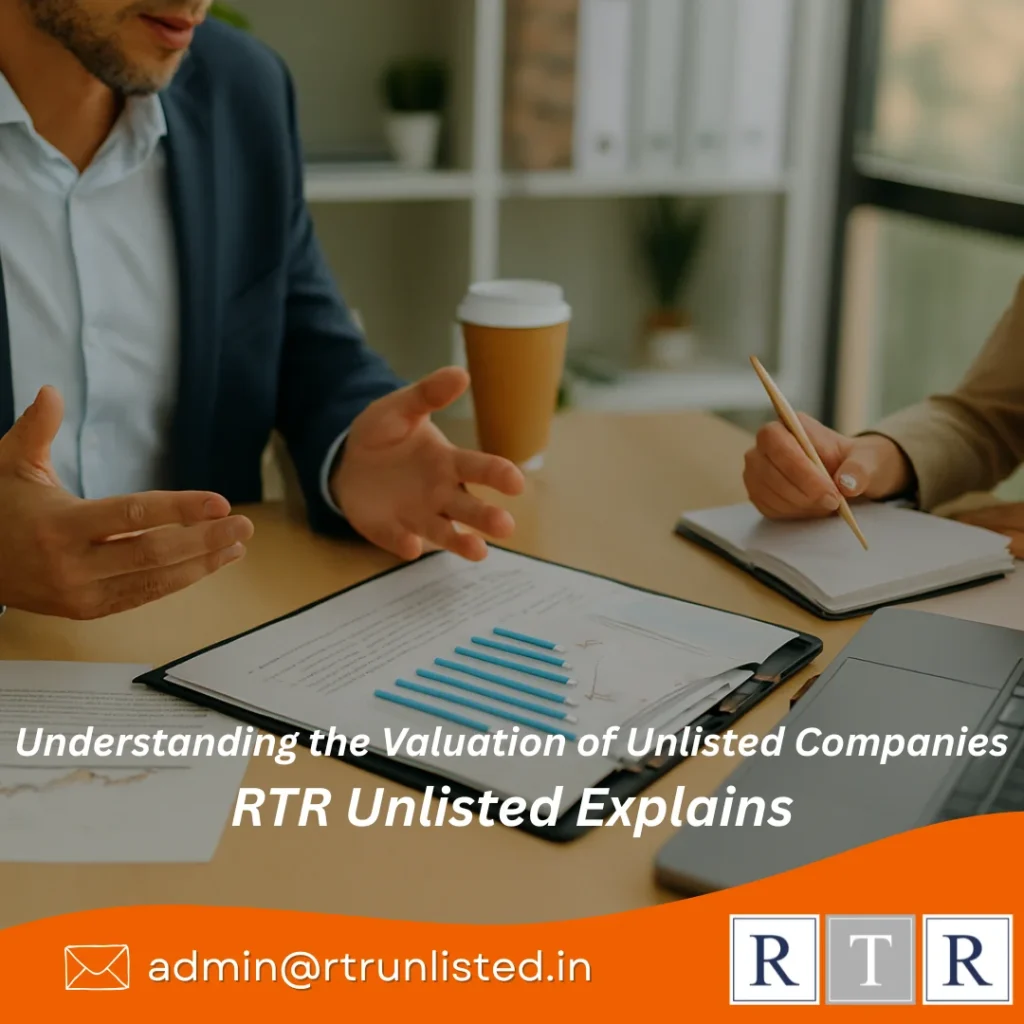
Valuing an unlisted company is both art and science. Without a public market price, investors, founders and advisors must rely on valuation methods, judgment, and rules to arrive at a fair number. This guide — brought to you by RTR Unlisted — breaks down the major approaches, regulatory and tax considerations (India-focused where relevant), practical examples, and a checklist you can use before you buy or sell unlisted shares.
Why valuation for unlisted companies is different?
Unlisted companies lack continuous market pricing, lower liquidity, and often have limited disclosure. That makes valuation more model-driven and assumptions-sensitive: small changes in growth, margins, or discount rates can move value materially. Professional valuers typically combine multiple methods and stress-test assumptions instead of relying on a single “magic” technique.
Main valuation approaches (simple, practical view)
1. Discounted Cash Flow (DCF) — the income approach
Project free cash flows (usually 5–10 years), then discount them to present value using a rate that reflects business and market risk. DCF is powerful because it ties value to future economic benefits, but it’s highly sensitive to growth and discount-rate assumptions. Use DCF when you have credible cash-flow projections.
2. Market / Comparables Approach
Use multiples from comparable listed companies or recent transactions (e.g., EV/Revenue, EV/EBITDA, P/E). For unlisted firms, pick peers carefully — industry, scale, growth, and margins should match — and apply appropriate discounts for size and liquidity. This method is market-anchored but depends on finding true comparables.
3. Net Asset Value (NAV) / Book Value — the asset approach
Values the company based on its net tangible (and sometimes intangible) assets. This is suitable for asset-heavy firms (manufacturing, real estate) or when earnings are erratic, but it can understate value for high-growth, intangible-rich businesses.
4. VC / Back-of-the-Envelope Methods (for early-stage startups)
For pre-revenue or early-stage companies, investors often use the VC method: estimate an exit value (based on comparables or expected multiples), then discount it back to present value using very high required returns. This method is pragmatic for fundraising negotiations.
Regulatory & tax considerations (India highlights)
Valuation for tax, RBI or regulatory purposed transactions may need to follow prescribed rules or recognized valuation standards. For example, India’s rules prescribe methods and formats for determining fair market value of unquoted shares (Rule 11UA and related guidance) and tax treatment (short-term vs long-term capital gains) differs for unlisted shares. Always check whether a transaction needs a professional valuation report under tax or regulatory rules.
How professionals combine methods (best practice)
-
Triangulate: Use 2–3 methods (DCF + comparables + NAV) and reconcile differences.
-
Apply discounts/premiums: Liquidity discounts, control premiums, and minority discounts are common adjustments.
-
Sensitivity analysis: Show how value changes with ± changes in growth, margins, and discount rate.
-
Use market evidence: Recent trades, secondary market prices for the same class of shares, or institutional transactions are very persuasive inputs.
Practical, step-by-step checklist for investors (quick)
-
Get the latest financials & management projections.
-
Choose 2–3 valuation methods suited to the business model.
-
Run base-case DCF and a conservative-case DCF.
-
Collect multiples from listed peers and recent private transactions.
-
Adjust for liquidity / minority / governance differences.
-
Prepare sensitivity tables (growth ±2–5%, discount ±2–4%).
-
Check tax and regulatory implications for the planned transaction.
-
If needed (large transactions), obtain a professional valuation report from a registered valuer.
Common valuation pitfalls (and how to avoid them)
-
Over-reliance on optimistic forecasts — sanity-check projections against industry trends.
-
Bad comparables — don’t use a high-growth unicorn as a peer for a mature small business.
-
Ignoring liquidity discounts — illiquid unlisted shares often trade at a meaningful discount versus listed peers.
-
Skipping tax/regulatory checks — can lead to unexpected tax liability or rejection by authorities.
Example (illustrative, simplified)
A small unlisted SaaS company expects ₹10 crore revenue next year with 25% annual growth for 5 years and improving margins.
-
DCF (base case) gives a present value of future cash flows = ₹(X) crore.
-
Comparable EV/Revenue multiple (peer set) suggests EV ≈ ₹(Y) crore.
-
After applying a 25–40% illiquidity discount and reconciling assumptions, the fair share value is set at ₹Z per share.
(Numbers vary widely by industry — run the math with your actual projections and multiple choices.)
How RTR Unlisted can help
At RTR Unlisted we aggregate live unlisted market intel, show recent secondary trades (where available), and explain model assumptions so you can interpret a valuation — not just accept a number. If you’re evaluating an investment or planning to sell, consider using multiple professional inputs and getting a formal valuation if the deal size or tax rules require it.
Quick glossary
-
DCF — Discounted Cash Flow
-
EV — Enterprise Value
-
NAV — Net Asset Value
-
Minority discount — reduction for lack of control/liquidity
-
Pre-money / Post-money — valuation before and after new investment
Conclusion & next steps
Valuing unlisted companies requires combining robust methods, realistic assumptions, and awareness of legal/tax constraints. Use DCF for cash-generating businesses, comparables where good peers exist, and NAV for asset plays — then reconcile results and stress-test them. If you’d like, I can:
-
build a one-page DCF model template for your target company, or
-
review a valuation (numbers you provide) and produce sensitivity tables and a short report.
Tell me which company or financials you want to value (or paste projections) and I’ll draft a clear DCF + comparables summary you can use in negotiations.
Sources:-
Here are the sources I used, along with their links:
-
“Business Valuation: 6 Methods for Valuing a Company” – Investopedia. https://www.investopedia.com/terms/b/business-valuation.asp Investopedia
-
“How to Value Private Companies” – Investopedia. https://www.investopedia.com/articles/fundamental-analysis/11/valuing-private-companies.asp Investopedia
-
“What Is Valuation? How It Works and Methods Used” – Investopedia. https://www.investopedia.com/terms/v/valuation.asp Investopedia
-
“A Guide to Valuation Methodologies for Private Companies” – Rundit. https://rundit.com/blog/a-complete-guide-to-valuation-methodologies-for-private-companies/ Rundit
-
“Section 11UA of Income Tax Rules, 1962” – Income Tax Department, India. https://incometaxindia.gov.in/_layouts/15/dit/pages/viewer.aspx?cname=cmsid&cval=103120000000007268&grp=rule&searchfilter=&utm_source=chatgpt.com Income Tax India
-
“Rule 11UA Valuation – ValAdvisor” – https://valadvisor.com/rule-11ua-valuation/ valadvisor.com
-
“Determination of Fair Value of Unquoted Shares” – TaxTMI. https://www.taxtmi.com/article/detailed?id=11808 TaxTMI
-
“Private Company Valuation | CFA Institute” – https://www.cfainstitute.org/insights/professional-learning/refresher-readings/2025/private-company-valuation CFA Institute
Mail us :- admin@rtrunlised.in
To Read More Blogs:- Click Here
